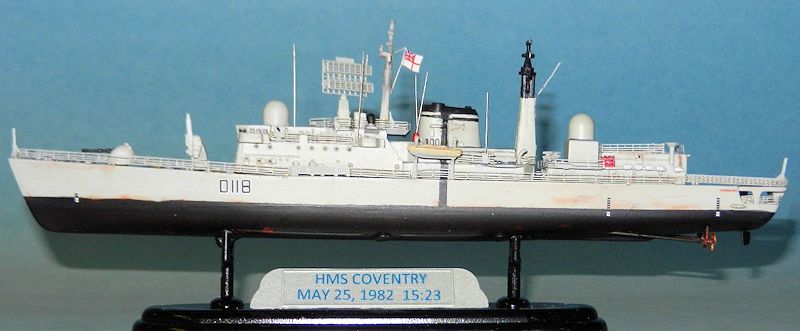
| KIT #: | 7133 |
| PRICE: | $23.50 SRP |
| DECALS: | Two options |
| REVIEWER: | Pablo Calcaterra |
| NOTES: |
Premium Edition.
|

| HISTORY |
HMS Coventry was
a Type 42 (Sheffield Class)
destroyer of the Royal Navy. She was launched in 1973 and accepted into service
on 20 October 1978. She was one of the Batch 1 ships. In
order to cut down costs she was 47 feet shorter at the bow and thus she
performed poorly at sea trials (batch 3 returned to the original designed length
and performed much better). Main mission for this type of destroyer was
mid-range anti-aircraft defense for which it was armed with Sea Dart missiles
(designed in the ‘60s). Secondary mission was anti-submarine (3 torpedo
launchers on each band) and anti-shipping (with a 4.5 in gun). For close defense
it only had a couple of WWII vintage 20 mm guns (one on each side close to the
bridge).
Her first
mayor deployment was in 1980 to the Far East where they did an official visit to
China and on their way back she patrolled the Persian Gulf for 6 weeks following
the start of the war between Iran and Irak.
In 1982 HMS
Coventry was taking part in Operation Springtrain ’82 along with most of the
British fleet in the Gibraltar area when, towards the end of March, information
started to arrive that meant that something big was afoot. The Royal Navy was
aware of the movements of the Argentine Armed Forces and was expecting an
operation against the Malvinas/Falklands Islands.
On April 2nd
1982 the news broke out. The Royal Navy was going to head south (almost 14,000
km) to retake the islands if negotiations were to fail. As admitted in a
documentary some of the British sailors were not aware of where the islands are
(some of them jokingly that the Argentines had taken some islands in Scotland).
During the trip south the ship was made ready for action with not needed
elements or things that could cause harm during action being thrown overboard
(bicycles, golf clubs)
Mission of
the three Type 42 destroyers was to provide forward long range air defense. As
such they were position further west than the rest of the fleet.
On May 2nd
ARA General Belgrano was sunk by HMS Conqueror with the loss of 322 sailors
outside the exclusion zone declared by the British and while sailing away from
the Task Force. News of the sinking reached HMS Coventry but no cheers was felt
by the sailors…they knew that this was war, they could be next and also feel a
great brotherhood with all sailors regardless of their country.
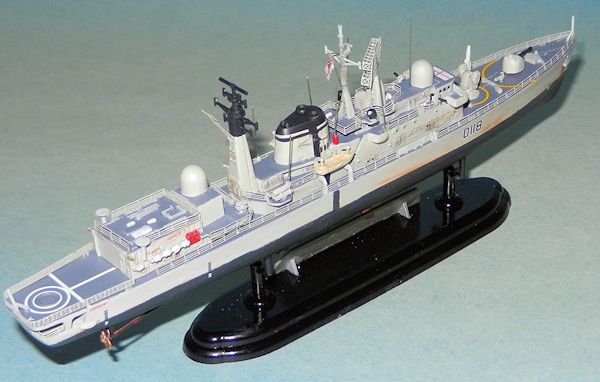 In the early hours of the morning of May 3rd
and while looking for survivors of an Air Force Canberra shot down two days
before, Aviso ARA Sobral of the Argentine Navy was found by a Westland
Sea King helicopter.
When the helicopter approached to
investigate, it was shot at by the vessel's 20
mm fore
cannon. The helicopter immediately retreated and called for assistance. As a
consequence
HMS Coventry and HMS Glasgow launched
their Westland Lynx HAS.Mk.2/3 helicopters. Coventry's
Lynx (XZ242) attacked first, firing two Sea Skua (air-to-surface) anti-ship
missiles. One of the missiles narrowly missed the bridge, the second hit Sobral's
fiberglass motorboat, injuring the crew of a 20 mm cannon and knocking out the
radio aerials. The crew of the helicopter saw the explosion in the dark and
believed that Aviso ARA Somallera had been destroyed
whereas the
Argentine vessel was not in the area.
They received a hero’s welcome (Twenty minutes later Glasgow's
Lynx launched two more missiles on what was believed (by Coventry) a different
target. One or perhaps both of these missiles struck the bridge, causing
extensive damage. In total the attack killed eight of the crew — including the
ship's captain, Lieutenant
Commander Sergio
Gómez Roca — and injuring eight.
The Sobral lost
all her electrical power, radio, radar and compass but was able to return led by
the 2nd in command. Sobral is still
in service in the Argentine Navy and the old destroyed bridge can be seen at the
Navy Museum in Tigre (close to Buenos Aires)
In the early hours of the morning of May 3rd
and while looking for survivors of an Air Force Canberra shot down two days
before, Aviso ARA Sobral of the Argentine Navy was found by a Westland
Sea King helicopter.
When the helicopter approached to
investigate, it was shot at by the vessel's 20
mm fore
cannon. The helicopter immediately retreated and called for assistance. As a
consequence
HMS Coventry and HMS Glasgow launched
their Westland Lynx HAS.Mk.2/3 helicopters. Coventry's
Lynx (XZ242) attacked first, firing two Sea Skua (air-to-surface) anti-ship
missiles. One of the missiles narrowly missed the bridge, the second hit Sobral's
fiberglass motorboat, injuring the crew of a 20 mm cannon and knocking out the
radio aerials. The crew of the helicopter saw the explosion in the dark and
believed that Aviso ARA Somallera had been destroyed
whereas the
Argentine vessel was not in the area.
They received a hero’s welcome (Twenty minutes later Glasgow's
Lynx launched two more missiles on what was believed (by Coventry) a different
target. One or perhaps both of these missiles struck the bridge, causing
extensive damage. In total the attack killed eight of the crew — including the
ship's captain, Lieutenant
Commander Sergio
Gómez Roca — and injuring eight.
The Sobral lost
all her electrical power, radio, radar and compass but was able to return led by
the 2nd in command. Sobral is still
in service in the Argentine Navy and the old destroyed bridge can be seen at the
Navy Museum in Tigre (close to Buenos Aires)
May 4th
found HMS Coventry, Glasgow and Sheffield (from North to South) in their battle
stations and ahead of the Task Force. Argentine Navy Trackers had found the
British and their radar emissions had been detected thus raising the alarm and
getting the defenses on edge. While HMS Glasgow was sure an incoming raid was
taking place it seems that HMS Sheffield was not and HMS Invincible even tried
to calm down the defenses claiming that it was a false alarm. Nevertheless
Glasgow and Coventry were on high alert and it not surprising that the only the
three D-42 that had not fired chaff as a precautionary measure was hit by an
AM39 Exocet fired by one of the incoming Super Etendards. Even though the war
head did not explode the fire lighted by the fuel of the missile took hold and
some days later, while being towed in high seas, HMS Sheffield sunk. Twenty of
her crew loss their life.
At 11:45 another Lear Jet arrived in the area. It
was called Litro 1 (Capt Argues/ Lt Cercedo/Lt Dominguez). While flying at
40,000 ft and in contact with the radar in Puerto Argentino/Stanley they were
ordered to break as fast as possible. They turned right and the radar operator
urged them to turn even faster and tighter. At that moment Lt. Dominguez saw a
missile flying past the tip of their wing. They dove fast and managed to get Rio
Gallegos.
HMS Broadsword radar saw the missile and planes
converging so claimed the planes shot down. Cheers erupted in HMS Coventry. The
first kills of the Sea Dart were claimed…but later on it was found that it was
not so (even though some British documentaries claim the contrary as late as
2007). It’s important to mention that according to the captain of HMS Coventry,
it was originally believed that these missiles were fired to an Hercules
escorted by Mirages, when in fact they had no visual and no way to verify this
information or who they were firing at.
As the Sea Darts confirmed the presence and
approximate position of the British ships, the Argentine Air Force launched
seven missions. The weather in that part of the islands was good, but the rest
was covered in 8/8 clouds.
One of those missions was OF 1174 made of four A4-C,
call sign TRUENO. Each plane carried one British bomb of 1,000 lb and were led
by Capt. Jorge Garcia, his wingmen being Lt Jorge Farias, Lt Jorge Casco, Ensign
Gerardo Isaac. They took off from San Julian. When trying to refuel from the
KC-130 tanker, Trueno 1 and 4 had problems so they turned back. Trueno 2 and 3
kept on flying, as their refueling was successful. Meanwhile, other missions
were aborting due to the solid cloud cover that was not allowing them to see the
surface of the sea. Now Casco took the lead, followed by Farias. They descended
into the clouds, looking for their targets. In such conditions, they should have
returned to base but they were too eager to press the attack. They flew under
the clouds, into showers and fog. They asked for an update of the position of
the ships (“Where are those d… ships!”) and they were answered that they were
farther East. So they kept on going. But the problem is that they had descended
too early and without knowing it, they were in the area of the Salvajes / South
Jason Is. On top of this, the radar in the islands was not able to see them as
they were still too far to the West, flying too low. No one heard or saw the
planes ever again.
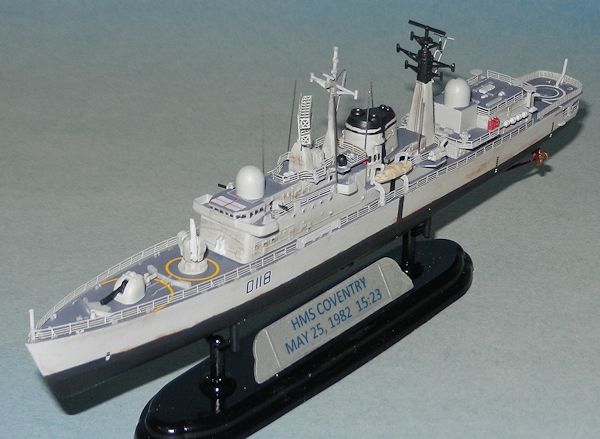 When learning that 2 Skyhawks had been lost in the
area on that date HMS Coventry’s captain Hart Dyke claimed them (assuming that
the Sea Darts seen to merge on the targets had been the A4-Cs when in fact it
had been the Lear Jets).
When learning that 2 Skyhawks had been lost in the
area on that date HMS Coventry’s captain Hart Dyke claimed them (assuming that
the Sea Darts seen to merge on the targets had been the A4-Cs when in fact it
had been the Lear Jets).
In 1982, after the war ended, C-313 was found with
the pilot still inside the cockpit. The plane had no trace of missile impact. In
fact, the island and the cliff were between Casco and HMS Coventry. It is clear
that with very bad visibility, Casco flew his plane into a cliff on the West
side of South Jason / Sebaldes Island. Though Farias plane has not been
positively found, there are indications that it might have crashed in shallow
water to the southwest of Casco’s last position. Lt. Jorge Casco is now buried
in the Argentine Cemetery in Darwin, Soledad/East Falkland. As Hobson stated in
his book, though HMS Coventry and HMS Broadsword claim these two Skyhawks shot
down, in fact the Sea Darts were fired at the high flying Learjets and the
Truenos (Skyhawks) were still too low and to the West for the 42-22 combo to be
able to “see” and engage them. Christopher Chant also confirms in his book that
the planes were lost due to bad weather.
Later on the same day the Argentine trawler Narwal
was found and attacked by Sea Harriers (Lt. Morgan and Lt. Cdr Batt from 800 Sqn
– HMS Hermes). This ship had an Argentine Navy member on board and they were
shadowing the Task Force. The ship called for help as they had been hit and was
sinking. The Air Force refused the request to send a helicopter to rescue the
survivors as the presence of the Harriers deemed the operation very risky. The
Army decided to send one of their SA-330-L Puma AE-505 with Lt. Fiorito,
Buschiazzo and Sgt Dimotta. While 13 miles away from HMS Coventry the helo was
hit by one Sea Dart fired by HMS Coventry. The target had been acquired by HMS
Broadsword and the information passed to HMS Coventry’s system. The combo 64 was
working. A tally with painted kills (3 by now!) was painted on one of the doors
of the ship.
During
Operation Sutton HMS Coventry and HMS Broadsword were placed to the North of San
Carlos water in order to shot down incoming raids meant to attack the landing
British Forces. Nothing was seen by the 64 combo until May 24th
more missions were scheduled to attack the landing area. OF 1227 (PLATA) was
made up of Capt Dellepiane in IAI Dagger C-434, 1st
Lt. Musso (a former Dagger pilot who had volunteered in early April to return to
the Air Force as he was by then a captain in Aerolineas Argentinas) in C-420 and
1st Lt. Callejo in C-421. PLATA
section reached the target area flying north of Pebble Island (Borbon) and then
reached the landing area. Musso said that he had to attack the small harbour in
San Carlos and they were fired at with guns, missiles and everything that the
British had at hand. He dropped his bombs on a ground target and he could see,
flying so low, the British soldiers aiming at them with portable anti-aircraft
missiles. He made several maneuvers to avoid the enemy fire and finally arrived
to the sea. He thought: “OK, I am saved” but he realized he was flying to the
EAST (towards Africa, as he remembers). Always skimming the waves, he turned to
the continent and close to the Northern entrance of San Carlos waters he found 2
British ships: HMS Coventry and Broadsword. He started to think: “they will hit
me, they will hit me” but he was not fired at. Some instants later and using the
same escape route Callejo faced the British ships as well. He flew towards the
islands to escape the “42-22 combo” and one of the ships fired a missile at him
though the captain of HMS Coventry says that the planes were out of range and in
his book does not mention firing a missile. Callejo immediately dropped his 3
empty 1,300 lt. tanks, turned sharply to the right and succeeded in evading the
missile. The seconds it took him to get to the coast of the islands seemed ages.
All the Daggers made it safely to their base albeit they were slightly damaged.
For details about these attacks you can read this
link.
Capt. Hart-Dyke requested permission to move his
ships further to the north, into open sea, in order to give their missiles a
better chance of defending themselves. They knew that they had been spotted the
day before and it was a matter of time before an attack was launched against
them. During May 25th (Argentina’s
National Day) several attacks to the beach head took place during the morning
(even though discrediting British authors say that the pilots were too busy
watching the soccer/football World Cup games). During two of these attacks
Skyhawks were damaged by small arms fire, were losing fuel and climbed to try to
save some during their return flight. Regretfully their path put them within
reach of HMS Coventry’s Sea Darts. The first to be shot down was the Capt.
Palaver (commander of the Squadron) in his A4-B Skyhawk C-244. The plane
exploded taking his life. Several minutes later another Skyhawk attack took
place on San Carlos. The leader (in this case the Squadron commander of the
A4-Cs) Capt. Garcia reported having his hydraulics damaged and climbed to the
north of Pebble/Borbon Island. He was hit by another Sea Dart (kill #3 of HMS
Coventry) and ejected. His parachute was seen coming down by the British sailors
but he was not rescued. He died of exposure and his body was found by two kids
close to his dinghy on a beach on Pebble Island in 1983. Even though it was
claimed that the Skyhawks were after HMS Coventry, truth is that they were
damaged and were trying to return to their base.
Finally a couple of sections were tasked with
dealing with this menace. They were OF 1236 (VULCANO): C-225 was flown by the
Capt. Pablo Carballo with Lt Rinke as his wingman (Ensg Carmona was forced to
return due to mechanical problems) and OF 1237 (ZEUS): 1st
Lt. Mariano Velazco (C-207), Ensg. J. Barrionuevo (C-212). Lt. Osses also
returned with mechanical issues. Each section had their own route, so they were
flying using different routes. Tactic for this type of attack had been practiced
many time by the Argentines: fly close to the surface of the sea with the planes
close to each other and the land as background. It was known that the multiple
echoes on the radar and a confusing background would confuse the system forcing
a shutdown to reset followed by a restart (thus the defenses would lose
approximately 6 precious seconds).
The attacking sections had been seen by Coventry’s
type 909 radar while 180 miles away taking fuel from their tankers. Coventry and
Broadsword knew that a raid was incoming. The now well-known shape of the
islands started to show on their windshields when a thin layer of salt started
to form on Carballo’s oval windshield. This had happened in previous missions
but had been solved by 1st Lt
(biochemist) Haggi, who
 found a solution to fix the problem. Carballo
immediately remembered non-commissioned officer Escobar, a mechanic who had
cleaned with all his love the windshield and who had asked Carballo if he was
satisfied with his job. He had cleaned away the solution! The Skyhawk pilot
considered returning to base because it was difficult to look forward and also
now his gunsight was useless. Therefore he would have to calculate the point
where to drop his bombs and decided to keep on going.
found a solution to fix the problem. Carballo
immediately remembered non-commissioned officer Escobar, a mechanic who had
cleaned with all his love the windshield and who had asked Carballo if he was
satisfied with his job. He had cleaned away the solution! The Skyhawk pilot
considered returning to base because it was difficult to look forward and also
now his gunsight was useless. Therefore he would have to calculate the point
where to drop his bombs and decided to keep on going.
They arrived to the first notification point,
Puerto Ruiseñor, and contacted the Rayo (tactical support aircraft), generally
operated by Vicecomodoro “Duro (Tough)” Pereyra and Major Medina. They would
tell them if their target had moved, where the enemy CAPs where…
Carballo soon discovered he was not going to be
able to follow the initial route, as he would not be able to fly above land from
Puerto Ruiseñor onwards, to Rasa Island (West of Borbon Is), due to his now
restricted visibility. Hence he started to fly a little bit away from the
original route.
The British radars lost and regained their track
many times because the planes were flying over land. But it was clear that there
were 2 planes followed by another 2. There was a section of Sea Harriers (Morgan
and Smith) being controlled by HMS Coventry and were available to try to take
out the raiders.
Skimming the water, as the only bumps are the
waves, the first Skyhawks flew towards the North of Gran Malvina/West Falkland.
To Carballo’s left and slightly lower and behind, almost touching the sea, was
his “Iron-made wingman” as he called him, Lt Rinke. Suddenly they were warned by
Ranquel (Pereyra):
“Careful as there is Harrier CAP entering the Sound
from the South!” It was Morgan and Smith chasing after the Skyhawks. Carballo
acknowledged and understanding that he could get to my target before they could
be intercepted, he decided to continue.
Diving on the Skyahwks, Thomas was able to get visual
while Dave was covering them, as all good wingmen do. At that moment, they were
ordered to break by Hart Dyke as the ships were going to take on the incoming
attackers. Frustrated, they turned away as they risked being shot down by their
own side.
Once the VULCANOs turned at the other extreme of
the island, they turned East and started to fly in the original direction. The
nose of their planes started to look for the place where the target should be.
There they were two dark dots, two impressive frigates against the horizon,
covered in mist, away from the coast, deep in the sea. Carballo thought: “This
time, it will be very tough as we will be exposed to their AA guns for a long
time”. Carballo gave full throttle, pressed the VHF button and said
“OK girls, I have them in sight, Long Live the
Homeland! Maximum power! To the one behind!” (The one to the West which was HMS
Broadsword)
They started the bomb run. Carballo felt very small
attacking those two huge steel constructions that commenced their defensive fire
the moment the Skyhawks entered the sea flying from Rasa Is, even though the
planes were not in range. Their hits were at the beginning far ahead: water was
dancing and jumping high and there were explosion in the air that formed a band
that seemed to be alive. The ships were covered in smoke after each shot.
Carballo thought they were in the middle of a sea battles movie. The wall of
fire was very dense and both ships were firing with everything they had, and the
salt on the windshield prevented Carballo from seeing how close their hits
where. The windshield has 3 parts and he could only see thru the ones on the
sides as the oval one (center) was covered in salt.
“Which one do we attack, sir?” asked Rinke.
“Let’s go to the one that’s behind, as it is less
defended” Carballo answered.
Both ships started to accelerate, with high lips of
water on their bows. They were heading East with approx. 200 meters of distance
between them.
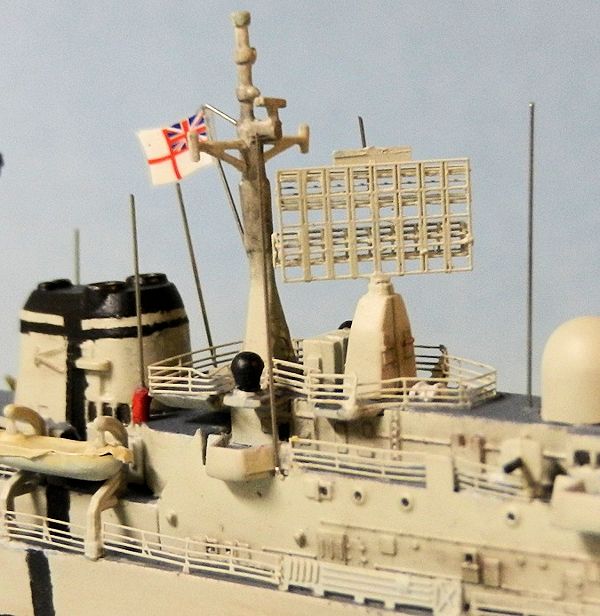 The tactic devised by the Argentines to confuse the
missile systems worked. HMS Broadsword’s Sea Wolf system failed again, as it had
happened on May 12th. This time, as
the planes were flying so close, the system could not decide what target to
shoot at first, so it turned itself off. It had to be reset manually, but the
process takes some seconds, vital seconds that they did not have. Both ships
were firing only with their guns and hand held armament given to their crew. No
missile was fired at the Skyhawks.
The tactic devised by the Argentines to confuse the
missile systems worked. HMS Broadsword’s Sea Wolf system failed again, as it had
happened on May 12th. This time, as
the planes were flying so close, the system could not decide what target to
shoot at first, so it turned itself off. It had to be reset manually, but the
process takes some seconds, vital seconds that they did not have. Both ships
were firing only with their guns and hand held armament given to their crew. No
missile was fired at the Skyhawks.
When Broadsword covered both sides of his blurred
windshield, Capt. Carballo let his 1,000 lb bomb go, waiting a little more time
than usual due to his bad forward vision. He remembers that Coventry was still
firing at them on their right.
“Did you pass, #2?”
He did not answer immediately but then Carballo got
very happy when I heard Rinke shout:
“Yes sir, I am here behind you and in sight!”
Almost at the same time, they heard another voice
in the radio:
“I don’t see anything!” It was 1st
Lt Velasco who was arriving with his second section.
Carballo shouted:
“They are just North of the IP (Rasa Is)! Go on, go
on!”
And Alferez Barrionuevo said:
“Ok, we have them to the left”
An explosion lifted a column of water close to
C-225 when he was fired at while escaping. Carballo said:
“I was hit, I think I was hit because I have felt
several hits underneath” (I had been hit by a small piece of shrapnel under his
right wing).
Broadsword had stopped, with a hole his her hull,
her landing deck and a hangar. The bomb had skipped on the ocean, jumped up, hit
the side of the ship going up, tore a hole on the landing deck, cleanly removed
the nose of her Sea Linx and fell on the sea on the other side (yet another
unexploded bomb dropped by the Argentines!)
Velazco and Barrionuevo started their attack. This
put her between the stopped ship and the attacking planes. Again 800 Sqn pair
started to track the second wave of Argentine planes, but for a second time they
were called off. This time Broadsword’s system were going to be fired on manual
mode so there was no chance that the system was going to fail again. The
Skyhawks were clearly in the center of the TV screen and locked in the radar of
the Sea Wolf system. Ready to fire, the operator said: “You will die, b…!”.
Aboard Coventry they felt that Broadsword had let
them down and that they were on their own. Broadsword was pointing to the East,
while Coventry turned West with an unbelievable agility, faster than what
anybody can imagine in order to give her armament on her other side a chance to
fire. A Sea Dart left the ship. The radar operator had acquired lock for a brief
instant but after being fired the missile started to wave trying to find the
target and passed above and to the left of the planes who did not change their
direction. While Rinke was retreating after his attack he was watching the
ensuing attack and shouted:
“The missile, the missile!”
Now finally with her side against the planes HMS
Coventry was giving everything she had.
The 20 mm gun
jammed. Everyone was firing with their hand held guns. Trev Trevarthen was
ordered to blind the pilots with the signaling projector which he found useless
so he did not carry out the order. The only thing that was left, as someone
said, was to throw their watches at the planes!
But when Coventry crossed in front of Broadsword
shielding her she blocked the latter’s radar lock and the missiles could not be
fired as they would have hit Coventry. Everyone aboard Broadswords command
center was startled. This meant that now the Skyhawks had a clean run to the
largest ship, HMS Coventry. Untouched by the small arms fire and after dropping
his bombs (Barrinuevos’ did not fall), Velazco asked the standard:
“Have you passed, #2?”
“Yes sir, you hit it perfectly, it was a CL42, I
saw her clearly, I almost crashed against one of the domes, I saw your bombs hit
the hull and in the other one, close to the water line, there was a column of
smoke!” The 4 pilots started to shout at the same time while they were still
being fired at, but the columns of water were quite behind. After a practically
quite trip back, except for Carballo’s concern about his loss of fuel due to the
slight damage to his plane (he even considered the option of ejecting in case he
run out of fuel), they made it back to their base.
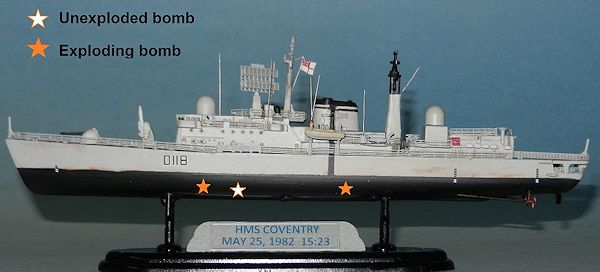 HMS Coventry had been hit by 3 bombs on her port
side one meter above the waterline. Silence followed the “thumps”. The one in
the center failed to explode but nevertheless contributed to the posterior
flooding (this was in the storage room). Another one entered below the bridge
and spiraled down from deck 2 to deck 4, below the computer room and exploded
killing everyone there almost immediately. The third bomb exploded as well, this
time in the Forward Engine Room and killed everyone in the dining room, located
above the FER. With fire on board and taking water, the ship started to list and
the damaged caused by the bombs only helped the water to rise to the upper
decks. Cannon hits from the 20 mm of the planes in the stern area contributed to
the flooding. Sadly, 19 members of HMS Coventry lost their lives. The rest, some
with terrible injuries and burns, made it safely to the boats. There was no
order to abandon ship. It was clear that she was doomed. Some tried to take the
Sea Lynx from the hangar and fly her away, but by the moment they were ready the
ship had listed so much that it was impossible to make her take off (and thus
she was lost with the ship). In 20 minutes HMS Coventry had turned over and
shortly afterwards capsized. Shortly afterwards, choppers from San Carlos
arrived to rescue the sailors. For details about the heroic deeds of the crew to
save each other Capt. Hart Dyke’s book is excellent.
HMS Coventry had been hit by 3 bombs on her port
side one meter above the waterline. Silence followed the “thumps”. The one in
the center failed to explode but nevertheless contributed to the posterior
flooding (this was in the storage room). Another one entered below the bridge
and spiraled down from deck 2 to deck 4, below the computer room and exploded
killing everyone there almost immediately. The third bomb exploded as well, this
time in the Forward Engine Room and killed everyone in the dining room, located
above the FER. With fire on board and taking water, the ship started to list and
the damaged caused by the bombs only helped the water to rise to the upper
decks. Cannon hits from the 20 mm of the planes in the stern area contributed to
the flooding. Sadly, 19 members of HMS Coventry lost their lives. The rest, some
with terrible injuries and burns, made it safely to the boats. There was no
order to abandon ship. It was clear that she was doomed. Some tried to take the
Sea Lynx from the hangar and fly her away, but by the moment they were ready the
ship had listed so much that it was impossible to make her take off (and thus
she was lost with the ship). In 20 minutes HMS Coventry had turned over and
shortly afterwards capsized. Shortly afterwards, choppers from San Carlos
arrived to rescue the sailors. For details about the heroic deeds of the crew to
save each other Capt. Hart Dyke’s book is excellent.
Thomas and Smith returned to their carrier,
“spitting nails”, completely angered and frustrated as they could have prevented
the catastrophe had they been given permission to engage the incoming Skyhawks.
In the meantime Broadsword limped away very slowly, her helicopter destroyed and
with a fire on board that was controlled shortly afterwards.
At the moment of her demise HMS Coventry was
credited with 1 Puma, 4 Skyhawks and one Aviso (Somallera) and thus was believed
to be the most successful anti-aircraft asset in the Task Force. As we have
seen, her true kills were the 2 Skyhawks on the 25th
and one Puma.
The place thru which, as tradition says, the
Skyhaws crossed Borbon/Pebble Is on their way to their target (in Pebble/Borbon)
has now been called “Skyhawk gap”. Close by there is a cross erected to remember
the lost ones on HMS Coventry.
HMS Coventry Roll of Honour
Frank Armes
After the war a team of divers removed sensitive
information and parts from the ship, along with items belonging to Capt.
Hart-Dyke, the bell of the ship and a cross of nails from the Coventry
Cathedral. This item was passed to the next HMS Coventry in the Royal Navy (a
class 22 frigate) until this one was decommissioned and then the nail was
returned to the Cathedral.
| THE KIT |
A preview of this kit can be found
here.
Basically the kit offers the options for two
Argentinian D-42 (ARA Hercules or ARA Santisima Trinidad – she has just sunk
while moored some weeks ago) and HMS Sheffield and HMS Coventry. Besides there
are dozens of parts for other ships. Some parts are clearly oversized for the
scale but in all you can find everything you need for these ships.
| CONSTRUCTION |
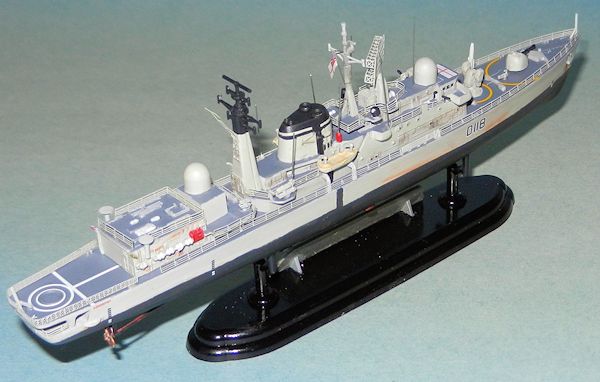
Basically I put together the two halves of the hull
and the main deck. Union of the two halves (top and bottom) of the hull is not
very good and required some putty.
All the different decks were tackled next. I followed
instructions for steps 8 and 9 but parts A2 and A15 did not seem to fit
together. The length achieved was too long when these two structures were put
one afterh the other. So something was fishy here and I decided to unglue it. It
took me a couple of nights and lots of search for clear pictures to find out
really where things go and how to attach them properly.
The big square antenna, made of 3 photoetched parts,
is much more convincing than the plastic one.
| COLORS & MARKINGS |
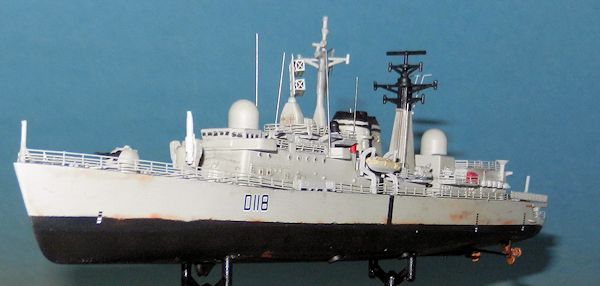
Here I realized that I had built deck over deck and
now painting was going to be a nightmare. I decided to paint the sides of the
ship first using MM Acryl 4765. Then I painted (following the instructions) the
hull in a mix of red and brown. Then the nightmare began. It took me 2 to 3
nights to mask all the walls of all the decks and the hull in order to protect
them and give the top surfaces a hand of MM Acryl 4754 (which is a tiny bit too
dark). At the same time I also left unmasked the middle band on the hull (to be
painted in black) and the black ID band that runs on the side of the ship
(including the funnel).
Having achieved the task without too many mishaps I
got the model pretty much ready for final assembly.
Per pictures of the ship some details were painted in
red.
| FINAL CONSTRUCTION |
Sanded black pastel was drybrushed around the mast
(A29) and in several areas to represent dirt and wear after weeks in the high
seas. This effect was enhanced with rust color pastels.
Landing lights on the helicopter hangar were painted
red and green.
The two launches were covered in tarpaulin in real
life. To achieve this I placed the launches face down over aluminum foil, cut
the foil around the edge of the launches and then glued it on top using cyano.
Then the foil was painted in light beige. By pressing it against the surface of
the plastic parts I achieved some realistic wrinkles.
Sea Dart launcher was positioned with only the left
missile left (the right hand side one had been fired at the second pair of
Skyhawks). The 4.5 in gun is slightly moved to one side as seen in the pictures
of the crippled ship.
The stand for the kit (pieces C7 to C10) was painted
in gloss black. Two pieces of lead were attached underneath to give it some
weight as the complete structure would have been pretty unstable without them.
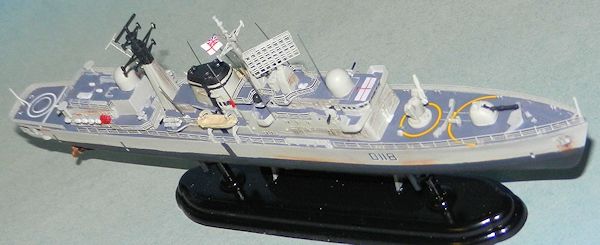 The plate for the name of the ship (HMS Exeter is
molded in the original part!) was sanded and painted in silver in preparation
for the decals I made with the name of the ship.The support was glued to the
hull and then protected by plastic film. The entire ship received a hand of
Future and decaling could start.
The plate for the name of the ship (HMS Exeter is
molded in the original part!) was sanded and painted in silver in preparation
for the decals I made with the name of the ship.The support was glued to the
hull and then protected by plastic film. The entire ship received a hand of
Future and decaling could start.
Then I proceeded with all the decals on the hull. A
piece of 0.010 stainless wire was vent, the flag (decal) was wrapped around it
and then attached to the main mast.
I printed HMS Coventry / May 25 1982 and the time of
the attack in clear decal paper. The plate was given a thick coat of Future with
a brush and later on the decal was carefully applied.
A couple of days later everything was sealed with MM Acryl Matt Clear.
Support for the antennas (painted in red) was made of
the 2nd Sea Dart (not used). All
antennas were made of 0.010 in stainless wire.
The propellers were glued after being painted in
bronze color. Note that the kit’s have 3 paddles but the ship’s actually had 5.
Oh well…!
At this point the ship was ready but for the photo
etched hand rails. I pondered leaving them aside but the ship was calling out
for them.
So, not having experience with such long etched parts,
I started with the area around the helicopter deck. It was not hard at all. It
only required a firm hand, a couple of pliers and a Xacto knife. Cyano (gel)
glue worked fantastic.
In three sessions at night I cut and glued all the
rails. Instructions on the kit are incomplete and a picture of a very nice large
scale HMS Coventry model helped me to install the missing one. I was left with
practically an entire part #1 (etched) not used.
…and to my horror I found I had a picture of Coventry
completely capsized and the color of the hood was not red (per kit instructions)
but black! So I had the option of letting you know not to make the same mistake
I did or correct it (to keep on being as accurate with the kits as I try to be
with the historical section).
 So I proceeded to mask carefully the black band on the
hull, put paper from that point onwards. While pressing the paper I snapped the
stand! But luckily nothing broke off. This proved to be a blessing in disguise
as it allowed me to paint the hull without anything on my way. Very carefully
and with low pressure I painted the hull in black leaving some areas where a
very little of the red can be seen. I glued the ship back again and that was the
end…I took the pictures again now with the black hull…
So I proceeded to mask carefully the black band on the
hull, put paper from that point onwards. While pressing the paper I snapped the
stand! But luckily nothing broke off. This proved to be a blessing in disguise
as it allowed me to paint the hull without anything on my way. Very carefully
and with low pressure I painted the hull in black leaving some areas where a
very little of the red can be seen. I glued the ship back again and that was the
end…I took the pictures again now with the black hull…
| CONCLUSIONS |
A nice little kit,
lots of parts, not so good instructions or fit but lots of detail can be added
to improve it beyond what I have done. Some pieces (like the Sea Dart and
launcher, 20 mm guns) are clearly oversized and unless scratchbuilt cannot be
fixed. Clearly ships are not my business…
| REFERENCES |
July 2013
Thanks to www.dragonmodelsusa.com via your editor for the review kit.
If you would like your product reviewed fairly and fairly quickly, please contact the editor or see other details in the Note to Contributors.